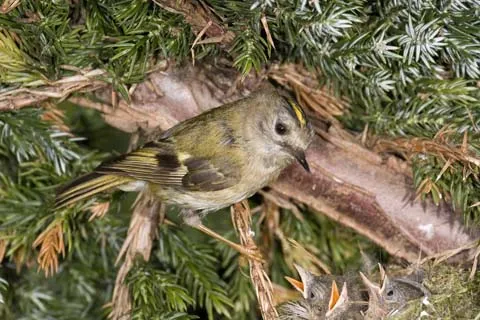The colourful goldcrest is the UK's smallest bird. Find out all about them in our expert guide.
How big are goldcrests?
The average goldcrest is no longer than 9cm and weighs around 5g, about the same as a 5p coin. They have a wingspan of around 14cm
What do goldcrests eat?
Associated with coniferous forests, goldcrests are almost entirely insectivorous and make the most of their light weight by foraging for spiders, moth eggs and other small insects in places where larger birds can’t go, like at the very end of small branches.
Why are they named goldcrests?
They get their name from their crest of bright, vibrant, feathers in the middle of their head, which is totally yellow on females, while males have an orange centre.
Goldcrest migration
Given their size, it is hard to believe that some goldcrests migrate to the UK from northern Europe, making them one of the lightest bird species in the world to migrate over the sea.
Due to the long journey it comes as no surprise that some stop halfway during their migration. Historically they have been known to use fishing boats, but these days they’re just as likely to use oil rigs found in the North Sea.
British breeding goldcrests don’t usually leave our shores, but they are known to move around within the country. Juveniles will disperse locally and some Scottish birds will move south of the border for the winter months.
However, these minute birds have been recorded as travelling even further. For example, one goldcrest that was ringed in Runcorn, Cheshire, was found 233km southwest the next spring near Haverfordwest, Pembrokeshire.
How do goldcrests survive winter?
The colder it is, and the longer the night, the more fat reserves goldcrests use up.
In fact they can use anything up to the equivalent of 20 per cent of their body weight. Therefore, goldcrests will often roost together at nighttime, reducing their heat loss, and then feed all day to replenish their fat reserves.
Unfortunately, in very cold winters up to 80 per cent of goldcrests might die by the spring. Thankfully, occasional mild winters and the great effort the species puts into breeding gives the population an opportunity to recover.
How many eggs does a goldcrest lay?
This diminutive bird can lay up to 12 eggs (the average is 6-8), which is equivalent to one and a half times the female’s own body weight.
Once the eggs have hatched, the female will usually lay a second clutch in a different nest while the male continues to feed the first brood.

A goldcrest and chicks © John Harding
When is the best time to spot a goldcrest in the UK?
Your chance of seeing a goldcrest increases during the spring and autumn when migrants are passing through, but goldcrests are found in gardens all year round according to the BTO Garden BirdWatch survey.
However, as they generally ignore our bird feeders, we rarely see them. During this time of year they need to keep their energy reserves up, so if you're lucky you might see one feeding on a fat ball.
How to identify a goldcrest
Goldcrests are no more than 9cm long – an obvious giveaway.
Their plumage is olive on top and buff-white below.
The wings are darker and have two white wing bars.
The crown, or ‘crest’, is flanked by a black edge and forms an orange or orange-yellow stripe on the male and a lemon-yellow one on the female.
Juveniles lack the crown stripe completely.
The only bird that you might confuse a goldcrest for is a firecrest, but these are much rarer, and only breed in South East England.
Main image: John Harding/BTO
The British Trust of Ornithology (BTO) works in partnership with over 40,000 volunteer birdwatchers to chart the fortunes of UK birds.
